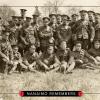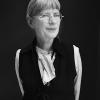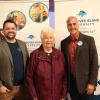September 7, 2006 - 5:00pm
Consider the barber, the confidant of men powerful or plebeian, whose domain is a centre for forging friendships, building business and getting a great haircut.
“Yet hardly anyone ever says ‘when I grow up, I want to be a barber’,” observes Mark Stuart, a second-generation barber who teaches the trade at Malaspina University-College. As a result, demand for good barbers exceeds the supply and those who take up the trade discover a growing market at their scissor tips.
“I just love it,” said Wendy Hicks, who opened Hicks Barber Shop in Duncan in November 2005, after graduating from Malaspina’s Barber/Stylist program the previous June. “Business is excellent.”
To handle the demand, Hicks has already expanded by inviting 2006 Malaspina graduate, Jennifer Morell, to join the shop. She chose Morell because she knew the standard set at Malaspina. “After doing well in the program, I knew she’d be good.”
Hicks always had a knack for cutting hair. She started with her toddler son, progressed to her husband’s hair, then to friends, and eventually had friends-of-friends knocking on her door for haircuts.
When she decided it was time for formal training, Hicks discovered Canada’s only stand-alone barber training course was half-an-hour away at Malaspina. Offered for the past nine years, the certificate program is accepting new students until October 1.
For Hicks, Malaspina’s course was perfect. The instruction was highly professional and precise. The class schedule, 3:30 to 9 p.m., allowed her to look after her four children during the day, with her mother-in-law and husband taking over in the afternoon and evening. In just nine months she gained the skills for her own successful business.
“Mark Stuart is a really good teacher, energetic and personable, and he made everything interesting,” Hicks recalled. “Mark had very high standards. So I knew if what I did was good in his eyes – then it was excellent. It made me very confident.”
The course included the history of barbering, which dates back to Ancient Egypt and has been a respected profession for centuries.
“Men’s haircutting is micro-management,” observes Stuart, a barber for 33 years. “The tolerances for error when cutting short hair are tiny – you can see the difference made by as little as a 32nd of an inch.”
Unlike women’s hair, where a poor cut can be camouflaged by post-cut styling, a man’s hair must fall into place. “People know when they’ve got a great haircut,” Stuart said.
Stuart also teaches shaving and face massage, along with hygiene, chemistry, anatomy, customer relations and business. One project requires students to complete the planning to open a shop, an exercise which gave Hicks the blueprint for her business.
Stuart noted that many graduates start with home-based barbershops. “You can grow your own business very quickly.”
More than half his students are women, drawn by the potential of a good income and flexible hours. In addition to their technical skills, good barbers are also good listeners.
“I think it’s hair-apy instead of therapy. Clients tell you everything – they trust you with everything,” Hicks said, adding that she deliberately forgets people’s secrets.
However, she feels the sense of community that builds within the walls of her business is part of the barbershop tradition.
In her updated version of a traditional shop, current techniques are applied to traditional services. Dressed in a barber smock, Hicks offers haircuts, straight razor shaving, hot towel shaves, and face massages.
Her clients frequently return to tell her that her haircuts are among the best they’ve received.
“I think I’m making Duncan a little more attractive,” she quipped. “But I always tell myself that I’m only as good as my last haircut.”
Tags: In the Community






